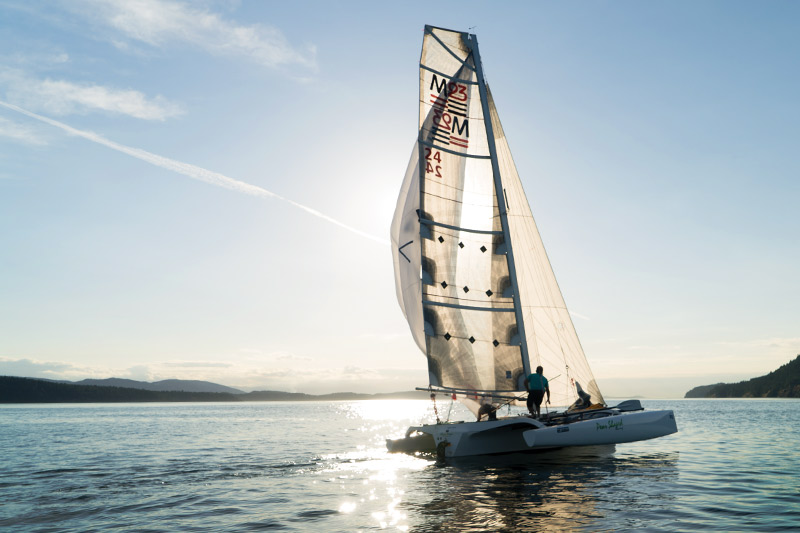
 he starting line of the Race to Alaska (R2AK) 2017 is blanketed by what I like to call a total “gray out,” a soup-like weather phenomenon where fog and water blend together into a gray stillness so complete that it can be hard to know which way is up. I stand on the flybridge of the media boat where I nurse a cup of courtesy coffee and double check my camera lenses before the starting gun at 05:00 hours. The winds tore through Port Townsend the night before, over 30 knots they say, yet this morning is calm with glasslike conditions. The wind is supposed to pick up later, and with a day of crossing the Strait of Juan de Fuca unfolding before the racers, I feel anxious even though I don’t have my hide on the line. I’m just a writer on assignment with Northwest Yachting magazine.
he starting line of the Race to Alaska (R2AK) 2017 is blanketed by what I like to call a total “gray out,” a soup-like weather phenomenon where fog and water blend together into a gray stillness so complete that it can be hard to know which way is up. I stand on the flybridge of the media boat where I nurse a cup of courtesy coffee and double check my camera lenses before the starting gun at 05:00 hours. The winds tore through Port Townsend the night before, over 30 knots they say, yet this morning is calm with glasslike conditions. The wind is supposed to pick up later, and with a day of crossing the Strait of Juan de Fuca unfolding before the racers, I feel anxious even though I don’t have my hide on the line. I’m just a writer on assignment with Northwest Yachting magazine.
The loosely assembled racers, from the paddleboarders to the performance multihulls, look less like a hardened pre-race fleet and more like a parade of odd experiments born from a maritime collaboration of Pinocchio’s creator Geppetto and Leonardo da Vinci. Monohulls feature pairs of home-installed threshing oars that, under other circumstances, would merit double, even triple, takes. Team North2Alaska, sailing a self-built aluminum Maryland fishing sharpie made by an Alaskan commercial fishing family, tanks a stagnant course as it waits to begin, while a small collection of paddleboards cluster. San Juan Island local Karl Kruger of Team Heart of Gold is among them. He is about to make R2AK history as the first to paddleboard the entire 750 nautical miles to Ketchikan. He accomplishes this superhuman feat by consuming specially made nutritional wafers every 20 minutes. I eat a complimentary doughnut aboard the media yacht. Mmm, maple bar!
Boom! The starting cannon of the Northwest Maritime Center reports from shore, and the racers are off – as much as they can be without wind to work with. The paddlers may have their day yet, and even begin to take the lead to the demoralization of the performance multihulls. From shore, hundreds of onlookers packed onto the boardwalk cheer as the Soviet-era Russian choir music rolls over the water from loudspeakers per R2AK tradition, extolling the glory of a defunct Motherland. The media boat plies the water effortlessly as I snap shots of the scene.
The music and festivities fade as we leave the starting line behind, and the only sounds beyond the media boat’s engines and my camera clicks are those of paddles and the occasional banging of limp rigging. The fun is over, and the “fun” begins.
TEAM WRIGHT YACHTS
SCOTT WALLINGFORD
AGE: 34 • Occupation: Yacht Broker • Experience: Sailor, norwegian celebrity, marine mechanic
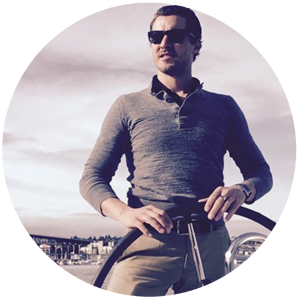
“Ever since I first set sail on the family’s Catalina 30 as a kid in southern California, I’ve wanted to do something like this! For years I’ve been working as a marine mechanic and now a yacht broker. Now we’re going for the gold, and no matter what, we’re going to have a lot of fun.”
I want to do it. I resolve inwardly, at once disdainful of my media yacht comforts and the promise of a warm bed awaiting me ashore. The maple bar turns sour in my mouth, the onboard heating, loathsome! But how?
Flash forward to today, and I’m preparing – physically, mentally, intellectually, spiritually – as a member of Team Wright Yachts, an alliance between brokerage Wright Yachts, Northwest Yachting magazine, and Corsair Marine International for the 2018 race. What was that saying grandpa was fond of? Be careful what you wish for? I should have been taking notes…
For the uninitiated, the R2AK (Race to Alaska) has emerged as one of the world’s most notorious adventure races. Organized by the hipsters of boating who call the Northwest Maritime Center of Port Townsend home, race organizer Jake Beattie and race boss Daniel Evans have been key personalities to the R2AK’s continued success since the race’s inception over beers.
“The idea crystallized at the 2014 Wooden Boat Festival in Port Townsend. There was a group of us sitting around in the beer garden and the conversation centered around how we get people on the water without engines and with sails came up,” Beattie told me in an interview before the 2016 race (that I also covered from the sidelines in our June 2016 issue as a feature, R2AK: Race or Revolution?). The philosophical foundation of what was to become R2AK was to challenge the rule heavy, big money, corporate way of doing things that Beattie and company perceived as dominating the sailboat racing world. The idea was to inspire greatness in the lay-sailor versus glorifying the haves over the have-nots. Where few of us watch the America’s Cup and think that they can participate, R2AK is meant to get sailors off their couches and onto the wild, glorious blue.
The race’s ban on resupplying and engines is also meant to bring seamanship back to its roots, away from the blinking screens, automation, and leisure cruising of the 21st Century. Yachting, this ain’t.
Beattie, Evans, and company schemed up the current two-leg, 750-nautical mile R2AK route from Port Townsend to Ketchikan. The first 40-nautical mile leg from Port Townsend to Victoria, B.C. across the Strait of Juan de Fuca is no joke. The exposed, often hellish, stretch of water is meant to wash out teams while they are still within easy recovery distance, and purposefully serves as a filter fairer than any formalized equipment list to keep unprepared teams safe from truly dangerous situations hundreds of miles from help. The first leg can also be raced on its own to give sailors who want a taste of the glory, but who don’t want to or can’t do the whole thing, a seat at the racer’s table.

Racers who make it to Victoria are rewarded with a festive evening and a free preparation day before taking on the 710-nautical mile stretch to Ketchikan. Obstacles like Seymour Narrows, with its jaw-dropping tide swing of 18 knots, litter the route as do the much talked about freight ships and grizzly bears.
At the end of it all, a $10,000 prize nailed to a piece of wood awaits the first-place team. Second place? A pair of infamous steak knives. Another rule instituted in 2017 was that each finisher is offered $10,000 for their boat, a tempting trade for the classic R2AK dirtbag badass who embraced the spirit of the race to complete it aboard some kind of marvelous homemade kiteboard/peddle/swan boat contraption made of milk cartons. But R2AK is not just about first place. It also features a swath of coveted awards, like the prestigious Dirt Bag Award for the finisher with the cheapest boat; that being the true goal of many participants.
TEAM WRIGHT YACHTS
KATHRYN RICHWINE
AGE: 30 • Occupation: NOAA CORPS OFFICER • Experience: arctic explorer, oceanographer, triathlete, diver
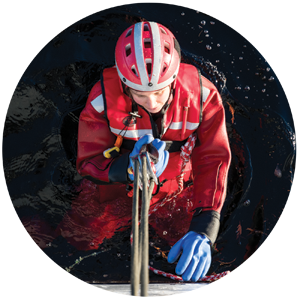
“I am looking forward to sailing with a great group of people and pushing the boundaries! The uncertainty of what lies between Victoria and Alaska is what fuels my fire, and I will not rest until we step onto the dock in Ketchikan!”
“Some of the best stories come from those who stick it out in a boat they pulled out of the blackberries bushes and fixed up,” says Daniel Evans. “Every finisher is a winner when it comes to this race.” With a reported completion rate of less than 40 percent, Evans’ sentiment is appropriate.
While the 2016 record still stands at three days, 20 hours, and 13 minutes by Team MAD Dog Racing (aboard a Marstrom M32 sailing catamaran), the many kayaks, rowboats, paddleboarders, and others often grabbed the spotlight away from the fast boats with harrowing stories such as making camp ashore to weather storms in Swiss Family Robinson-esque experiences. The first iteration of the race in 2015 gained international fame as racers and press from all over the world flocked to participate and watch. The upcoming 2018 race will be the fourth iteration, and buzz around whether the 2016 speed record will fall, and what other epic firsts await, is ubiquitous in boat nerd circles.
The beginnings of Team Wright Yachts came about over beers, not unlike the seed of the idea that would lead to R2AK’s creation. Yacht broker Scott Wallingford and I met for the first time at Hattie’s Hat in Ballard to reminisce over a Norwegian reality TV show we had both “starred” in, Alt for Norge. The show takes 12 Americans of Norwegian decent who’ve never been to Norway before and pits them in elimination-style cultural challenges for the grand prize: to meet one’s estranged Norwegian relatives. Turns out, we both lived in Seattle and wanted to story swap about the experience.
970 SPORT
The Corsair 970 Sport is an evolution of the Corsair 31(C31), and is a performance trimaran that’s built to both zip around the race course and take on the wildest horizons. With more interior space and functional tweaks to the rigging and layout, the 970 is touted by the manufacturer to have the performance of the C31 with the comforts of the larger C37. Not only that, but the boat’s patented folding system puts the boat onto a trailer for marina-less storage and increased versatility. For more information, check out local dealer Wright Yachts website at wrightyachtsales.com. Contact them for pricing.
SPECS
LOA: 31’ 10”
Beam (unfolded/folded): 22’ 7”/8’ 4”
Draft (daggerboard up/down): 1’5”/6’10”
Mast Length: 44’ 3.5”
Local Dealer: Wright Yachts, 206-356-8698
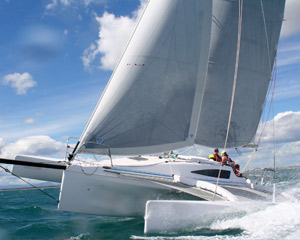
“We joke around that Norris is the ‘boat guy’ from Season 5, and I’m the ‘boat guy’ from Season 6,” says Wallingford. “I guess it’s a popular trope over there. Vikings and all.” With an estimated viewership of over 500,000 (about a tenth of Norway’s population) and annually awarded the Gulruten Award (aka Norwegian Emmy, “Nemmy”) for best Reality TV Show, Alt for Norge is recruiting for Season 9 at the time of this writing.
Wallingford and I would remain good friends, initially bonding over a Norwegian reality TV show and ultimately over a love of boats and sailing. He a broker and I Northwest Yachting magazine’s managing editor and was a liveaboard at the time. R2AK was on both our bucket lists, and from then on always managed to worm its way into conversation when boats and beer were combined.
Wallingford ultimately ended up working with Rob Wright of Wright Yacht Sales, a small brokerage with a Shilshole Bay Marina office. He wasn’t working long for the brokerage before I was invited on a fateful sail with not only Rob Wright, but Australian Richard Ward, the owner and designer of Seawind sailing catamarans whose company had recently acquired Corsair Marine International. I excited for a great day of sailing, but a surprise awaited me at the dock.
“Katie?!” I blurted as I stepped aboard to behold none other than NOAA Corps Officer and one of my marine science college peers from Eckerd College in Florida, Kathryn Richwine. Since graduation, she has been cutting her nautical teeth at sea for the last two years deployed aboard the NOAA Ship Fairweather above the Arctic Circle. Now a full-fledged mariner with stories to back it up, I certainly didn’t expect to see her aboard.
“Norris?!” She laughed. “What are the odds?” I’m still crunching the numbers on that one. She introduced me to Li Sung, a not-active-duty Navy Commander who is a partner with Rob Wright’s chartering company aboard the Seawind 1160 catamaran Amelia (that we sailed that day) while attending the University of Washington for his PhD in Ocean Engineering. Turns out, Sung is an active member of the university’s human-powered submarine team, he is a sort of human-powered inventor genius.
TEAM WRIGHT YACHTS
LI SUNG
AGE: 40 • Occupation: ocean engineering PHD STUDENT/amelia catamaran charter partner • Experience: NAVY OFFICER/ENGINEER, UW human-powered submarine inventor, mad genius
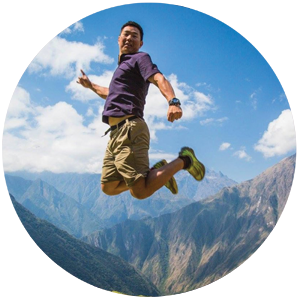
“Why I’m doing the race? Just thought it’d be something really cool to do. Meet some new people around here and do epic stuff!”
What became a fantastic reunion sail with Rob Wright, Richard Ward, Li Sung, and Kathryn Richwine turned fateful as R2AK once again entered the conversation after a few *responsible* beers were consumed. We parted ways, but it wasn’t long before I got the text from Wallingford: “It’s happening dude. R u in?”
Team Wright Yachts took form: Officer Richwine the Arctic explorer, Li Sung the Navy Commander and mechanical genius submariner/budding professor, and the two Norwegian sailor TV personalities. But we needed a boat, and Rob Wright and Richard Ward delivered. In a move that also showcases one of Corsair Marine International’s newer builds, Wright Yachts secured a Corsair 970 Sport for our use in the race.
“Richard Ward and I had been talking about ways to grow Corsair in the Pacific Northwest, so the timing of it all is just too perfect,” says Rob Wright.
The 970 is an evolution of the Corsair 31 (C31), a similar boat to 2017’s second-place Team Big Broderna’s Corsair F31R. The four-crew team lost their first-place position by a mere six minutes to Team Pure & Wild/Freeburd, a three-crew team aboard 8.5 trimaran, who passed them on the home stretch.

The C31 has also been the boat of choice for a highly publicized Arctic adventure during which legendary Norwegian sailors and explorers Børge Ousland and Thorleif Thorleifson transited both the infamous Northwest and Northeast Passages of the Arctic in a single season.
“The Corsair 970 Sport is the kind of boat that’s been proven to perform in this race during years past,” said Rob Wright. The manufacturer touts the 970 as having 15% more interior space, a more functional extended cockpit, aft deck mainsheet track, and high-volume floats for increased stability compared to the C31. Like the C31 before it, the 970 features a retractable daggerboard design, and is completely trailerable with the patented folding system.
Now that Team Wright Yachts has the basics covered, namely crew and boat, the real challenge has begun. As the team members officially register and fall into their perspective roles, preparation becomes the name of the game.
“It’s exciting!” says Michelle Gibbon-Zeasman, owner and publisher of Northwest Yachting magazine. “If we lose our managing editor, I’ll cry… but if he comes back with those damned second-place steak knives, I’m cutting off all his toes with them!” Gibbon-Zeasman and Wright are spearheading the managerial side of Team Wright Yachts to do what they can to support the crew with gear sponsorships. Unfortunately, none of us have “secret bored millionaire” as our schtick.
“There’s so many ways to approach the human-powered element to this race,” says Sung, who plans to draw from his human-powered submarine, academic, and Navy experience to give the team an edge when peddle power can be the six-minute difference between ten grand and steak knives.
Richwine, who is training for a marathon and regularly places on the state level as a triathlete, is eager to plot the course and
get going. “I’ve spent literally years professionally mapping this region of the world and navigating through it,” she says. “It’s pretty funny how all of our backgrounds are coming together to make the team. I’m glad I don’t skip leg day.”
TEAM WRIGHT YACHTS
NORRIS COMER
AGE: 28 • Occupation: NORTHWEST YACHTING Managing editor • Experience: teller of yarns
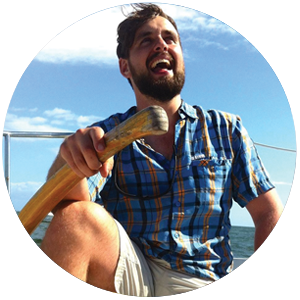
“I’m sick of writing about this damned race! I want to live it, get mangled by it, and laugh when it spits me back out again. Just as mountains are meant to be climbed and not merely ogled, so too is R2AK. To feel the chill and the bite and the scale of it all will be a euphoric hallelujah!”
Wallingford, who equips, maintains, and delivers boats for a living, has naturally embraced the logistics side of things. “There are so many factors at play, from what kind of food we should eat to what kind of electronics we want to have aboard,” says Wallingford. “I definitely have my work cut out for me, but a lot of it is what I do professionally.”
One looming milestone is the commissioning of the boat, which is currently being constructed at the Corsair Marine International factory in Vietnam. The team is planning to go in person to check it out, and be able to say, “back in ‘Nam,” in casual conversation.
“I’m looking forward to that final round of Q and A at the factory,” says Rob Wright, who is shepherding the racing machine from drawing board to Ketchikan. “The trip should be awesome!”
Come June 14, I will once again hear the cannon of the Northwest Maritime Center of Port Townsend that marks the start of R2AK. Unlike last year, where the biggest question on my mind was whether or not coffee will be aboard the media yacht, I will be among the collection of misfit watercraft adrift in a classic Pacific Northwest gray-out. Yachting in the Northwest comes in many forms, I suppose.
Stay tuned for updates, both of our team and others we interview along the way. As the Norwegians say, “ut på tur, aldri sur!”